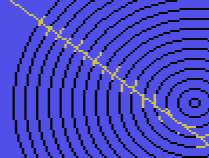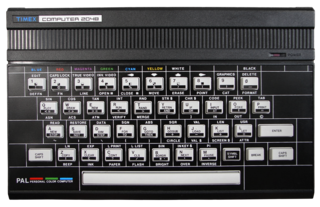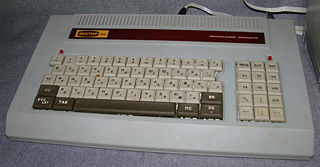Related Research Articles

The Amstrad CPC is a series of 8-bit home computers produced by Amstrad between 1984 and 1990. It was designed to compete in the mid-1980s home computer market dominated by the Commodore 64 and the ZX Spectrum, where it successfully established itself primarily in the United Kingdom, France, Spain, and the German-speaking parts of Europe.
The Konix Multisystem was a cancelled video game system under development by Konix, a British manufacturer of computer peripherals.
The Sinclair QL is a personal computer launched by Sinclair Research in 1984, as an upper-end counterpart to the ZX Spectrum.

The ZX Spectrum is an 8-bit home computer developed and marketed by Sinclair Research. Considered one of the most influential computers ever made, it is also one of the best-selling British computers ever, with over five million units sold. It was released in the United Kingdom on 23 April 1982, and around the world in the following years, most notably in Europe, the United States, and Eastern Bloc countries.
Flare Technology was a computer hardware company based in Cambridge, United Kingdom. It was founded in 1986 by Martin Brennan, Ben Cheese, and John Mathieson, former engineers at Sinclair Research.
In computer graphics, planar is the method of arranging pixel data into several bitplanes of RAM. Each bit in a bitplane is related to one pixel on the screen. Unlike packed, high color, or true color graphics, the whole dataset for an individual pixel is not in one specific location in RAM, but spread across the bitplanes that make up the display. Planar arrangement determines how pixel data is laid out in memory, not how the data for a pixel is interpreted; pixel data in a planar arrangement could encode either indexed or direct color.

The SAM Coupé is an 8-bit British home computer manufactured by Miles Gordon Technology (MGT), based in Swansea in the United Kingdom and released in December 1989.

The Timex Sinclair 2068, released in November 1983, was Timex Sinclair's third and last home computer for the United States market. It was also marketed in Canada, Argentina, Portugal and Poland, as Timex Computer 2068.

Attribute clash is a display artifact caused by limits in the graphics circuitry of some colour 8-bit home computers, most notably the ZX Spectrum, where it meant that only two colours could be used in any 8×8 tile of pixels. The effect was also noticeable on MSX software and in some Commodore 64 titles. Workarounds to prevent this limit from becoming apparent have since been considered an element of Spectrum programmer culture.
Sinclair Research Ltd was a British consumer electronics company founded by Clive Sinclair in Cambridge. It was originally incorporated in 1973 as Westminster Mail Order Ltd, renamed Sinclair Instrument Ltd, then Science of Cambridge Ltd, then Sinclair Computers Ltd, and finally Sinclair Research Ltd. It remained dormant until 1976, when it was activated with the intention of continuing Sinclair's commercial work from his earlier company Sinclair Radionics, and adopted the name Sinclair Research in 1981.

Wonder Boy is a 1986 platform game published by Sega and developed by Escape. Originally designed for arcades, it was later ported to the SG-1000, Mark III/Master System and Game Gear video game consoles by Sega, and to the ZX Spectrum, Commodore 64 and Amstrad CPC home computers by Activision. The game is also known as Super Wonder Boy for its Sega Mark III release in Japan and Revenge of Drancon for its Game Gear release in North America. A high definition remake of the game, titled Wonder Boy Returns, was developed by CFK and released on Steam on October 12, 2016. Wonder Boy was rereleased in 2022 as part of Wonder Boy Collection for the Nintendo Switch and PlayStation 4 which includes its versions on arcade, Master System, SG-1000 and Game Gear.

The original ZX Spectrum computer produces a one bit per pixel, bitmapped colour graphics video output. A composite video signal is generated through an RF modulator, and was designed for use with contemporary 1980s television sets.

The Timex Computer 2048 or TC 2048 is a 1984 computer developed by Timex Portugal, at the time part of Timex Sinclair. It was based on the Timex Sinclair 2048 prototype, with a similar redesign case, composite video output, Kempston joystick interface, and additional video modes, while being highly compatible with the Sinclair ZX Spectrum computer.

Vector-06C is a home computer with unique graphics capabilities that was designed and mass-produced in USSR in the late 1980s.

Zub is a 1986 platform video game designed by Ste and John Pickford, developed by Binary Design, and published by Mastertronic for the Amstrad CPC, Commodore 64 and ZX Spectrum. The game has the player control Zub, who has to travel to different planets to retrieve the Green Eyeball of Zub. A parody of the game Light Force, called Lightfarce, was added in as an easter egg. The music on all computers was composed by David Whittaker.

The Unipolbrit Komputer 2086 was a Polish version of the home computer Timex Sinclair 2068, produced by a joint venture of the Polish state-owned Unimor and foreign company Polbrit International. Introduced in 1986, the computer had a cost of roughly 190000 zł.

The Sinclair ZX Printer is a spark printer which was produced by Sinclair Research for its ZX81 home computer. It was launched in 1981, with a recommended retail price of £49.95.

Light Force is a 1986 vertically scrolling shooter designed by Greg Follis and Roy Carter, developed by their company Gargoyle Games, and published under their Faster Than Light imprint. It was released for the Amstrad CPC, Commodore 64, and ZX Spectrum platforms.
The TC 3256 or Timex Computer 3256 was a 1987 computer created by Timex of Portugal, a branch of Timex Corporation.
References
- 1 2 Red, Johnny (2001). "Sinclair "Loki"". Timex Computer World. Retrieved 2022-11-23.
- ↑ Owen, Chris (2003). "Loki, Janus, Pandora - The Unreleased Sinclair Computers". Planet Sinclair. Retrieved 2022-11-23.
- ↑ Adamson, Ian; Kennedy, Richard (1986). "Sinclair and the 'Sunrise' Technology: The Quantum Leap — to where?". Planet Sinclair. Retrieved 2007-06-03.
- ↑ "Loki: Taking the programmer's view". Sinclair User . No. 52. July 1986.
- ↑ Pennycook (2012). "Sinclair Loki documentation - The proposal for the Sinclair Loki Super-Spectrum computer". Flickr.
- 1 2 Smith, Tony (February 19, 2014). "Loki, LC3 and Pandora: The great Sinclair might-have-beens". The Register. Retrieved 2022-11-23.
- ↑ "SuperSpectrum!". Sinclair User (51): 24–25. June 1986. Archived from the original on 2007-07-07. Retrieved 2007-06-02.
- ↑ Goodwin, Simon (August 1986). "TECH TIPS - LOKI THE JOKI". CRASH. No. 31.
- ↑ "Is Sinclair's Loki fated to stay in Limbo?". Popular Computing Weekly. 22 May 1986. p. 5. Retrieved 16 January 2024.
- ↑ "Mystery clouds Amstrad deal". Sinclair User. July 1986. p. 7. Retrieved 16 January 2024.
- ↑ Taylor, Graham (August 1986). "Sir Clive Life After Death?". Sinclair User. pp. 54–56. Retrieved 16 January 2024.
The Loki papers are still sitting somewhere in the depths of the company, Amstrad has no rights to it because it was a future product but Sinclair cannot do anything with it because being Spectrum compatible it would infringe Amstrad's legal rights.
- ↑ Thomas, David (February 1997). "Loki The Machine That Never Was". Format. Vol. 10, no. 6. pp. 19–21. Retrieved 16 January 2024.
- ↑ Owen, Chris (2003). "Loki, Janus, Pandora - The Unreleased Sinclair Computers". Planet Sinclair. Retrieved 2022-11-23.